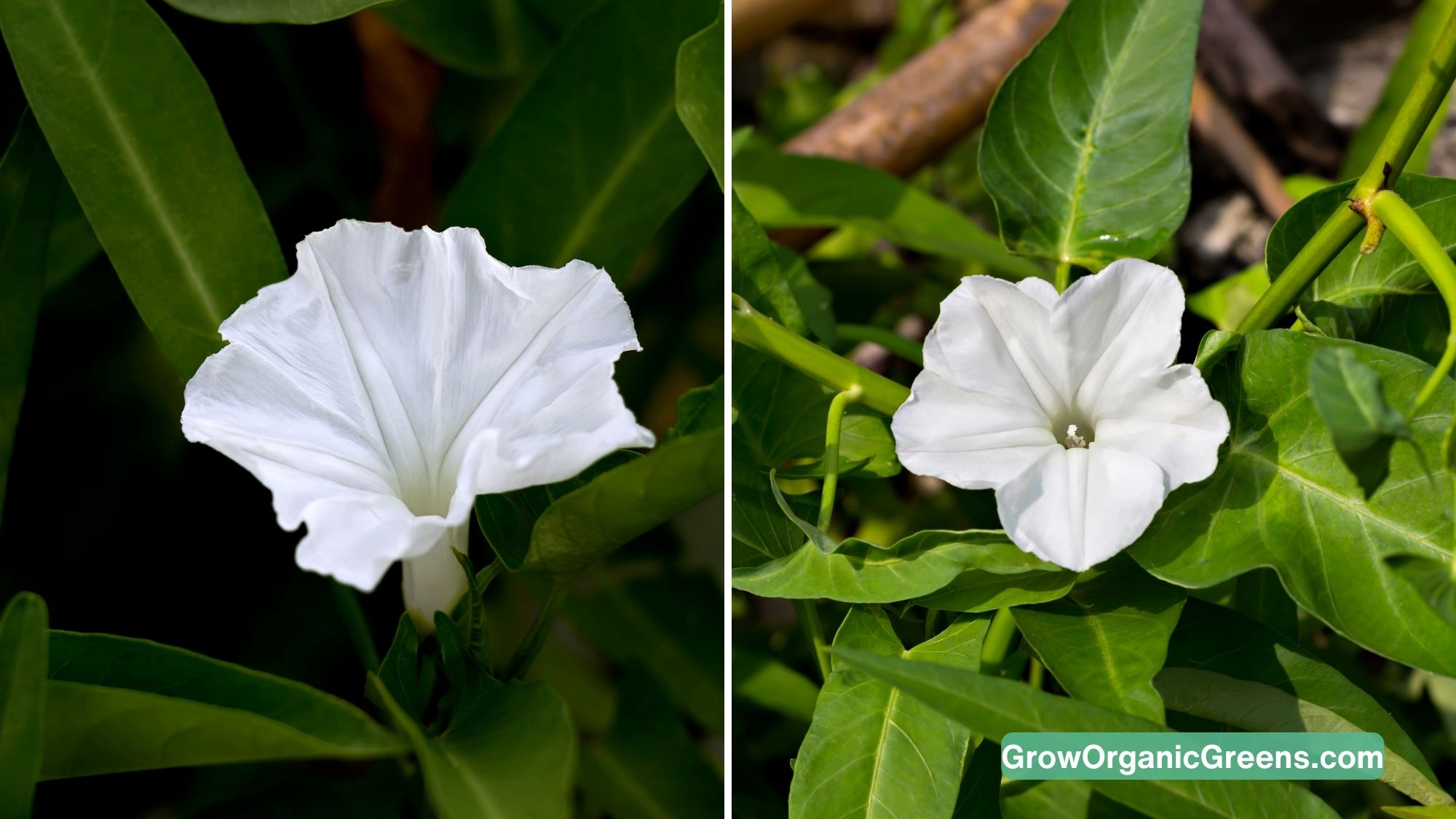Moonflower Morning Glory is a captivating and enchanting plant known for its large, fragrant, nocturnal blooms. This guide will provide you with all the essential information on how to grow and care for this beautiful plant, ensuring it thrives and adds charm to your garden.
Are you looking to add a touch of magic to your garden that comes to life in the evening? Moonflower Morning Glory might be the perfect choice. In this article, you’ll learn all about growing and caring for Morning Glory and explore the different types of Morning Glory. Let’s explore how to bring the enchanting beauty of Moonflower Morning Glory to your garden.
How Does It Look?
Moonflower Morning Glory features large, white, and fragrant flowers that open in the evening and close by morning, creating a magical display under the moonlight. The large green buds unfold into these stunning blooms. The leaves are heart-shaped and dark green, providing a lush backdrop that enhances the luminous white flowers. This combination of large, fragrant flowers and rich green foliage makes Moonflower Morning Glory a standout plant.
Native
Native to tropical and subtropical regions of the Americas, Moonflower Morning Glory brings exotic allure to gardens with its enchanting blooms.
Hardiness Zones
9-11 (USDA). Search your hardiness zone.
Annual/Biennial/Perennial
Moonflower Morning Glory is grown as an annual in temperate regions and as a perennial in tropical climates.
Requirement at the Time of Plantation
For best results, plant Moonflower Morning Glory in well-drained, moderately fertile soil. It thrives in locations with full sun, which ensures vigorous growth and abundant blooms. The ideal planting time is in spring, after the last frost, giving the seeds or seedlings the warmth they need to flourish. Ensure optimal soil conditions by conducting soil testing to create the best environment for growth.
Blooming Season
Moonflower Morning Glory blooms from mid-summer to fall, offering a continuous display of vibrant color.
How to Take Care
To ensure optimal growth, plant Moonflower Morning Glory in an area that receives full sun. A light application of balanced fertilizer supports its growth and blooming. Regular watering is crucial, especially during dry periods, to keep the soil consistently moist but not waterlogged. Consider using a slow drip watering system to maintain moisture levels. Using organic mulch helps retain soil moisture and suppress weeds.
Companion planting with other climbing plants or using Moonflower Morning Glory to cover fences, trellises, and arbors enhances the visual appeal of your garden and provides a lush, green backdrop for the luminous flowers. The large, fragrant, nocturnal blooms make this vine an excellent choice for adding dynamic beauty to garden structures. Learn more about companion planting strategies to optimize your garden ecosystem.
Uses
- Aesthetic: Moonflower Morning Glory is known for its large, fragrant, nocturnal blooms, making it a popular choice for garden decorations, fences, trellises, and arbors.
- Medicinal: This variety is not used for medicinal purposes.
- Culinary: Moonflower Morning Glory is not used for culinary purposes.
How to Propagate
Propagation of Moonflower Morning Glory can be achieved through seeds. Plant the seeds directly in the garden after the last frost, or start them indoors a few weeks earlier and transplant them outside once the weather warms up.
Problems and Organic Solutions
Common pests include aphids and spider mites, which can be managed using neem oil or insecticidal soap. Fungal diseases, such as powdery mildew, can be controlled by ensuring good air circulation and applying organic fungicides when necessary.
Special Facts
Moonflower Morning Glory is not just a visual delight but also attracts nocturnal pollinators like moths, adding ecological value to its aesthetic appeal. For more tips on attracting pollinators, consider incorporating other flowering plants in your garden. Its rapid growth and ability to cover large areas quickly make it an excellent choice for gardeners looking to add a touch of enchanting beauty to their outdoor spaces.
Conclusion
Incorporating Moonflower Morning Glory into your garden can bring both visual splendor and ecological benefits. With its large, fragrant, nocturnal blooms, relatively easy care requirements, and rapid growth, this annual vine is a wonderful choice for gardeners of all skill levels. Ready to transform your garden with the enchanting beauty of Moonflower Morning Glory? Start planting today and enjoy the magical blooms all summer long.
Quick Facts Table
| Aspect | Details |
| Appearance | Large, white, fragrant nocturnal blooms; heart-shaped, dark green leaves |
| Native | Tropical and subtropical regions of the Americas |
| Hardiness Zones | 9-11 (USDA) |
| Lifespan | Annual in temperate regions, perennial in tropical climates |
| Plantation Requirements | Well-drained, moderately fertile soil; full sun; plant in spring after last frost |
| Blooming Season | Mid-summer to fall |
| Care Needs | Full sun; light application of balanced fertilizer; regular watering; organic mulch; companion planting with other climbers |
| Uses | Large, fragrant, nocturnal blooms; garden, fence, trellis, and arbor decoration |
| Propagation | Through seeds |
| Problems & Solutions | Aphids and spider mites (neem oil, insecticidal soap); fungal diseases (good air circulation, organic fungicides) |
| Special Facts | Attracts nocturnal pollinators; rapid growth |

Misty S is the founder and lead writer at GrowOrganicGreens.com, a comprehensive gardening resource dedicated to helping people cultivate beautiful and sustainable gardens. She has a Master’s degree in Economics and specialized studies in agricultural economics, horticulture, and soil science. Drawing from her extensive knowledge and experience, Misty shares practical gardening tips on soil preparation, organic manure composting, fertilizers, plant care, and indoor gardening, making her advice accessible and helpful to gardeners of all levels.
Despite having an high-demanding 9-5 job, Misty dedicates her personal time to researching and exploring various gardening topics. Her keen interest in gardening has grown into a passion, driving her to help new gardeners and anyone interested in starting their gardening journey.
Follow Misty’s work and the latest gardening insights and updates on Pinterest. You can reach out to Misty at mistysblogging@gmail.com.

